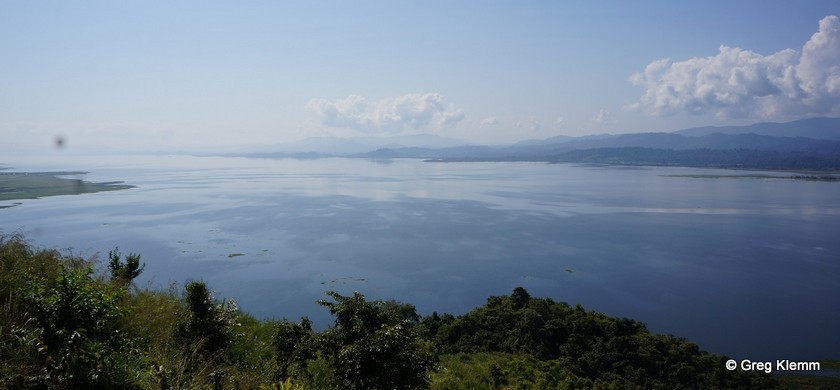
Indawgyi has also become something of an adventure destination with kayaking, trekking, cycling and recreational fishing all on offer. Inn Chit Thu (Lovers of Indawgyi) Tourism Group is a community-based organisation made up of local people that rent out kayaks and bicycles; they can also organise trekking and recreational fishing trips. Their profits go towards funding environmental conservation and community projects.
Lonton village and accommodation
The only foreigner-licensed accommodation at Indawgyi Lake can be found in Lonton village, on the west shore. IndawMaHar guest house is a delightful spot, perched right on the lake, with a welcoming and generous manager. Facilities are fairly basic with simple rooms and a shared bathroom, but it’s low-impact and fits perfectly with the environment. There is also a military-owned guest house in Lonton and if the guest houses are full then there are homestay options nearby.
If you do try to call IndawMaHar guest house by phone, do not hold out for an immediate answer – communications are very unreliable in this area. Both guest houses are located on the main road through Lonton, and pick-ups and taxis will drop foreigners off at IndawMaHar guest house as a matter of course; you do not need to ask.
Sights around the lake
Shwe Myitzu Pagoda
The most famous landmark at Indawgyi Lake, Shwe Myitzu Pagoda is beautiful from the water, especially as it casts its reflection in the late afternoon sunlight.
The pagoda festival held here in February or March attracts more than 100,000 people from the surrounding area. At that time of year, towards the end of the dry season, the water level is low enough that you can walk across to the pagoda from the mainland on a wooden walkway. For exact dates and full Myanmar festival listings, go to our festival calendar.
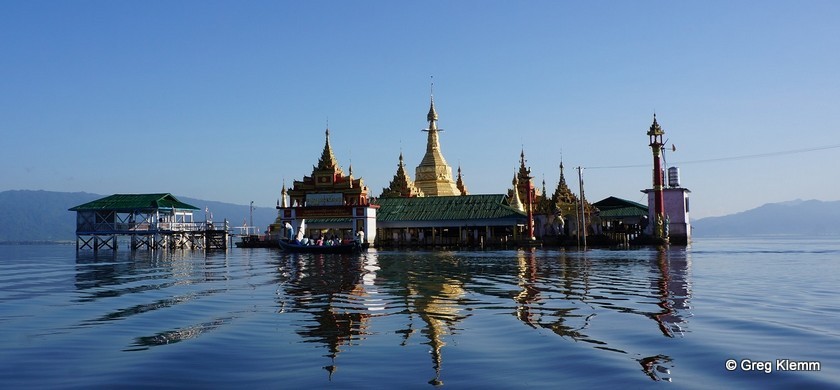
Shwe Taung (Golden Mountain)
Rising from the northern shore of Indawgyi Lake, Shwe Taung is pagoda-topped hill that provides great views of the lake in its entirety. It’s only a 25 minute walk up the hill from the lake at a moderate incline, and there’s a monastery on the way where the friendly locals are likely to offer you some refreshments. Due to its distance from Lonton village, Shwe Taung can only be reached by motor boat or motorbike (it is too far to cycle or kayak in a single day). Note that motorbikes in the Indawgyi lake area can only be rented with driver (self-drive is not permitted).
Lake-side villages
There are a number of lakeside villages dotted around Indawgyi; visiting them and interacting with the local people is a highlight for most visitors. Some of the most interesting villages are listed below. Namde and Nammilaung also have houses that are home to elephants.
- Lwemun Village. Set on a hillside about half-way up the western shore, Lwemun is perhaps the most picturesque village on the lake. It has two monasteries, a nat (spirit) shrine and a shrine which tells the story of Indawgyi Lake. The story is that there used to be a village right below the current Lwemun when the lake didn’t exist.
A widow had a dream that the area would be filled with water and left to the hill with some animals. The other villagers didn’t believe her, but then sure enough the village was flooded and the lake came to exist.
One of the monasteries is at the southern end of the village, the other is about halfway through (heading along the main north-south road). There is a roadside teashop at the very north of village has great views and very good cold noodle salads. Across the street from the teashop, there are stairs up to the nat shrine, and just before the teashop (when coming from the south) are stairs down to the shrine celebrating the widow’s dream. Her footprint is supposedly down there as well, but can only be seen during the dry season.
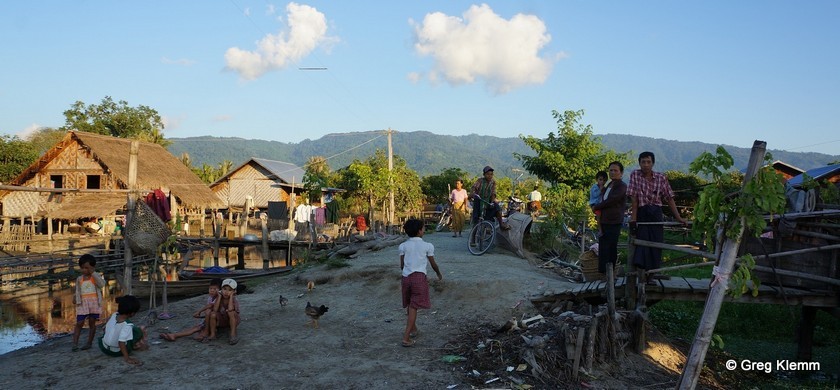
- Hepa. The lake front of this village on the east shore is especially scenic. The first few houses on each of the east-west streets that reach the lake are built on stilts, which the lake flows under when it is at its highest level. Further to the east (back) of town you reach the main north-south road which runs up the eastern shore of the lake. A short walk or ride south or north along this road will reveal some lovely scenery of rolling fields stretching towards the eastern mountains behind.
- Namde. Set back from the lake shore, Namde is most notable as the turn-off point to Shwe Myitzu Pagoda and for the house which is home to two elephants. The elephants (male and female) are kept in the second house south of the turn-off to Shwe Myitzu Pagoda (the sign to the Pagoda is in English) and opposite the office of the Tai-Leng Nationalities Development Party (also signed in English).
- Nammilaung. Not the most beautiful village on the lake, but notable for its interesting architecture with high wooden fences around all the houses. Nammilaung also has a cane Buddha image, which was made as a communal effort by local people. The cane Buddha image is in a complex on the main north-south road, right next to the archway over the road. Next door, across the east-west street to the south is an old teak monastery. On the fourth street south from the cane Buddha complex is another house which has elephants. Head down this street towards the lake and it’s on a corner with a narrow north-south lane (the only house with an iron gate).
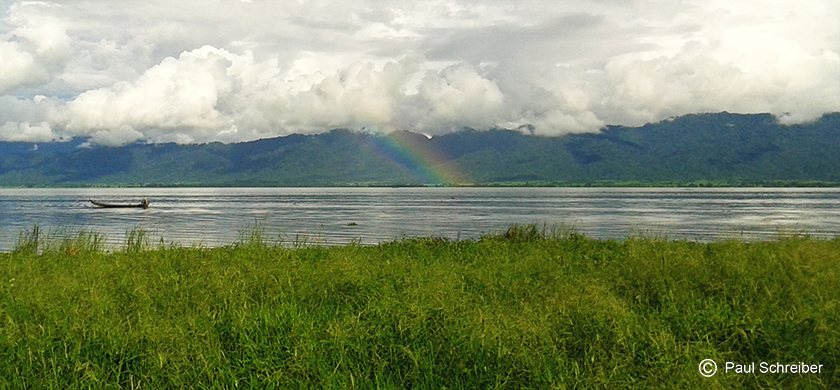
A note on the elephants: seeing the elephants is hit and miss. Sometimes they are away for two or three days at a time carrying logs in the forest. But if you visit the houses at both Namde and Nammilaung you might get lucky with at least one of them.
Activities
Kayaking
At roughly 24 kilometres by 13 kilometres, Indawgyi Lake is too big to cover by kayak in one day, but it is wonderful to be out on the water’s serene expanses, with no one in sight (or earshot). Inn Chit Thu gives advice on suggested routes that are manageable for most people and take in Shwe Myitzu Pagoda, as well as villages on the western and south-eastern shores. Experienced kayakers might want to push on a bit further.
Kayaks cost K15,000 per day to rent; there are single-person and two-person kayaks available in Lonton village.
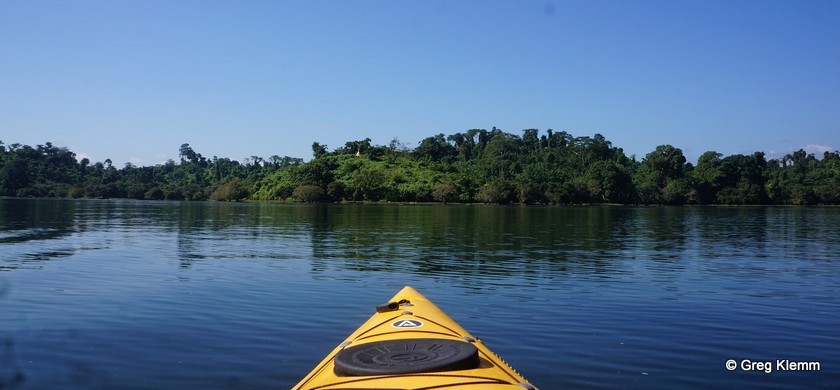
Cycling and motorbiking
Heading north from Lonton, you arrive at the mainland opposite Shwe Myitzu Pagoda – where you can visit a hilltop sitting Buddha and take photos of the pagoda if you don’t visit by water. Foreigners are not currently allowed to hire a motorkbike due to safety and security concerns. However, travel by motorbike within Inn Chit Thu is permitted so long as tourism officials are alerted ahead of time and you are accompanied by a local guide.
Trekking
Foreigners are not able to go into the mountains on the west side of the lake due to Kachin Independence Army activity and illegal gold mining. This means that trekking routes generally start a good distance from Lonton and transport to and from the start and finish points can be pricey. The local trekking guide (guides are necessary in these mountains) costs K10,000 per day. Currently there are routes in the south-eastern mountains and the eastern mountains (behind Hepa), with more to be explored. Inn Chit Thu can provide advice.
Boating and fishing
The price of one day’s motor boat hire at Indawgyi Lake is quite high at K50,000 to K60,000. In a way, that is a blessing – as so much of Indawgyi’s appeal is the relative peace and quiet. However, if you want to circumnavigate the entire lake in one day whilst being on the water, motor boat is the only way to do it. Inn Chit Thu can also organise recreational fishing trips.
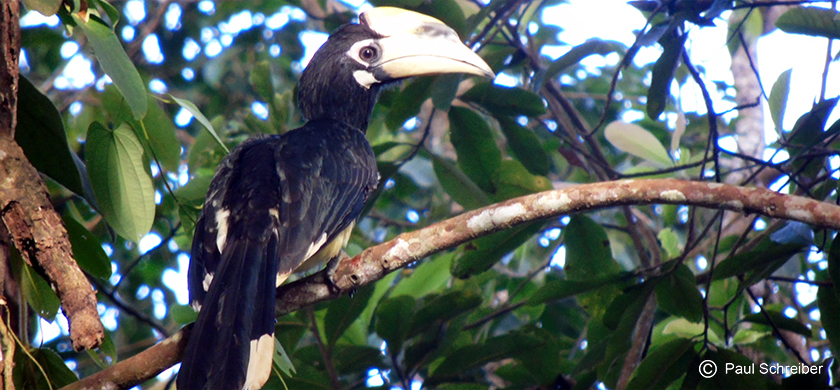
Bird watching
In recent years, most of the tourists who have made it to Indawgyi Lake have been avid bird watchers, and the lake has a strong reputation within that community. The lake is a major stop for migratory birds and attracts thousands of them from December to March. Even for those who aren’t enthusiasts, the sight of thousands of birds on the lake, and flying in flocks over it, is something to behold.
When to visit Indawgyi Lake
From October to December visibility is at its best, and it’s often possible to see the entire lake – most impressive in the late afternoon light. From January onwards, the visibility gradually becomes worse, getting hazy at times. But the serenity of the location remains and the arrival of the migratory birds provides its own touch of magic.
We offer a variety of tours of Myanmar that include Indawgyi Lake - find out more here.







